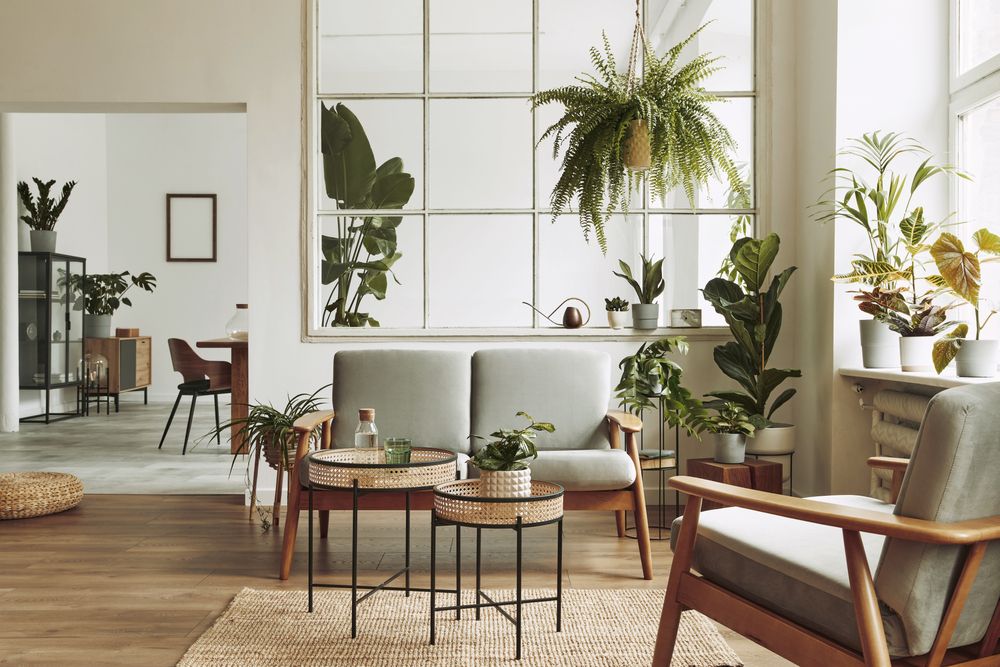Fresh air is one of life’s necessities—but when we spend so much time indoors, it’s easy for pollutants and stale odors to linger. That’s where houseplants step in. Far from just decorative accents, certain indoor plants can help clear the air by filtering out common toxins while adding a natural touch to our living and working spaces. Whether you’re an experienced plant enthusiast or a newbie to greenery, this guide will walk you through the best indoor plants for improving air quality, along with tips for keeping them healthy. With the right choices, you can breathe easier and enjoy a more vibrant indoor environment.
1. Why Indoor Plants Help Purify the Air
Why It Matters
Back in the late 1980s, a NASA study popularized the notion that certain houseplants can remove volatile organic compounds (VOCs) like benzene, formaldehyde, and trichloroethylene from indoor air. Since then, additional research and anecdotal reports have reinforced the idea that greenery can enhance our indoor environment—both by filtering pollutants and by introducing humidity and oxygen into the air.
Key Ways Plants Improve Air Quality
- Gas Exchange: During photosynthesis, plants take in carbon dioxide and release oxygen.
- Absorption of Pollutants: Some plants have a knack for absorbing low concentrations of VOCs, which may be emitted by paints, adhesives, or cleaning products.
- Humidification: Plants release moisture vapor through their leaves, which can help balance indoor humidity.
Takeaway: While no plant replaces the need for proper ventilation and minimal chemical use, the right greenery can provide a helpful boost in creating a fresher, healthier home.
2. Golden Pothos (Epipremnum aureum)
Why It’s Great
Often topping lists of “hard-to-kill” houseplants, Golden Pothos (also called Devil’s Ivy) stands out for both resilience and air-purifying abilities. Its trailing vines and glossy heart-shaped leaves make it a popular choice for hanging baskets or shelves.
Air-Cleaning Strengths
- May help remove formaldehyde and xylene, byproducts of adhesives and vehicle exhaust.
- Thrives in various light conditions—though bright, indirect light fosters faster growth.
Care Tips
- Water: Let the top inch of soil dry before watering; overwatering can lead to root rot.
- Light: Tolerates low to medium light but shows more variegation in moderate brightness.
- Temperature: Grows best in typical indoor temperatures (60–85°F / 15–29°C).
Takeaway: If you’re a beginner or have limited sunlight, Golden Pothos’s easygoing nature and air-filtering qualities make it a fantastic first pick.
3. Snake Plant (Sansevieria trifasciata)
Why It’s Great
Also known as Mother-in-Law’s Tongue, the Snake Plant is famed for its upright, sword-like leaves that feature unique green and yellow patterns. In addition to its bold look, it’s among the most tolerant houseplants—surviving infrequent watering, low light, and a range of indoor climates.
Air-Cleaning Strengths
- Targets formaldehyde, benzene, and trichloroethylene, found in everyday materials and cleaning solutions.
- Unlike many plants, it releases oxygen at night, possibly aiding better sleep if placed in a bedroom.
Care Tips
- Water: Allow soil to dry thoroughly between waterings. Overwatering is the biggest threat, as Snake Plants are susceptible to root rot.
- Light: Prefers bright, indirect light but adapts to low-light corners.
- Temperature: Thrives in standard indoor climates and can handle cooler nights.
Takeaway: The Snake Plant’s hardy nature makes it a top choice for those wanting a low-fuss plant that also helps filter indoor air, especially in bedrooms or offices.
4. Spider Plant (Chlorophytum comosum)
Why It’s Great
The Spider Plant’s arching leaves and baby “spiderettes” that dangle from the mother plant lend an airy, graceful touch to interiors. It’s also recognized by NASA’s research for its knack in removing formaldehyde and xylene.
Air-Cleaning Strengths
- Acts as a steady worker in absorbing certain indoor toxins over time.
- Known for its easy propagation, thanks to offshoots that can be potted into new plants.
Care Tips
- Water: Likes consistent moisture but not waterlogged soil. Water more frequently in warm months.
- Light: Grows best in bright to moderate indirect light. Too much direct sun may scorch leaves.
- Temperature: Generally does well in 65–75°F (18–24°C), though it can handle brief dips.
Takeaway: If you love the idea of multiple baby plants and a gentle “fountain” look, the Spider Plant offers both decorative appeal and air-cleansing benefits.

5. Peace Lily (Spathiphyllum)
Why It’s Great
With glossy leaves and elegant white “flowers” (spadix and spathe), Peace Lily adds a tranquil, tropical vibe to any space. It’s also praised for purifying multiple indoor pollutants, like ammonia, benzene, and formaldehyde.
Air-Cleaning Strengths
- Considered one of the more effective plants in tackling an array of VOCs.
- Releases moisture, potentially boosting indoor humidity—helpful in dry climates.
Care Tips
- Water: Keep soil evenly moist but not soggy. Peace Lily droops as a sign of thirst, bouncing back once watered.
- Light: Thrives in medium to low indirect light, though a bit more brightness can encourage blooms.
- Temperature: Prefers normal indoor ranges; avoid drafts or temps below 60°F (15°C).
Takeaway: For a flowering plant option, Peace Lily offers both aesthetic flair and robust air-purifying capabilities—though watch out for overwatering.
6. Dracaena (Various Species)
Why It’s Great
Dracaena varieties—like Dracaena marginata (Dragon Tree) or Dracaena deremensis (Warneckei)—deliver spiky, upright foliage that can add height and dimension to small indoor spaces. They’re fairly forgiving plants, making them well-suited for novice growers.
Air-Cleaning Strengths
- Effective at absorbing airborne toxins such as benzene, trichloroethylene, and formaldehyde, common in glues and paints.
- The robust leaves aid in humidifying indoor air.
Care Tips
- Water: Keep soil slightly moist but allow the top layer to dry between waterings. Avoid standing water or soggy soil.
- Light: Medium to bright, indirect sunlight is ideal. Some Dracaena species can adapt to lower-light settings.
- Temperature: Standard indoor temperatures are fine, but avoid chilling below 60°F (15°C).
Takeaway: If you want a taller, striking plant to fill a corner while filtering the air, Dracaena offers versatility in style and minimal fuss.
7. Rubber Plant (Ficus elastica)
Why It’s Great
Known for its thick, glossy leaves, the Rubber Plant can grow into a substantial focal point in your home. It’s admired for being relatively easygoing if you provide consistent light and watering.
Air-Cleaning Strengths
- Notable for removing formaldehyde from indoor air.
- Larger leaves mean more surface area for oxygen production and potential pollutant absorption.
Care Tips
- Water: Likes moderately moist soil—water when the top few inches dry out, being careful not to overwater.
- Light: Prefers bright, indirect light to maintain leaf vibrancy. Some direct morning or late afternoon sun can be beneficial.
- Temperature: Does well in 65–80°F (18–27°C). Keep away from cold drafts or extreme heat.
Takeaway: For a statement plant that improves air quality, a Rubber Plant’s bold presence can enhance a room’s look while quietly working on pollutant removal.
8. Placement and Care Considerations
Why It Matters
Even the best air-purifying plants won’t thrive if placed poorly or neglected. The synergy of location, watering schedule, and occasional maintenance will determine long-term success.
Tips for Success
- Clustering Plants: Grouping plants can boost humidity, supporting each other’s growth. Keep in mind each plant’s specific light needs.
- Cleaning Leaves: Dust buildup on leaves can hinder photosynthesis and air filtration. Gently wipe leaves with a damp cloth every few weeks.
- Rotating Plants: Turn the pot occasionally so all sides receive adequate light, preventing lopsided growth.
- Watch for Pests: Overwatering and stagnant conditions can attract fungus gnats or spider mites. Promptly address any infestations.
Takeaway: Good plant care—consistent watering, suitable light, and occasional leaf-cleaning—helps these air-cleaning wonders thrive and continue purifying your indoor environment.
9. Realistic Expectations
Why It Matters
While these plants can certainly help reduce certain toxins, they aren’t a magic solution for poor indoor air. Proper ventilation and minimal use of harsh chemicals remain critical.
Pointers
- Ventilate: Open windows when possible or run exhaust fans to cycle in fresh air.
- Manage Sources: Reduce or remove pollutants (like strong adhesives or off-gassing furniture) at the source whenever possible.
- Consider a Mix: Combining multiple plant varieties can offer more comprehensive coverage of different VOCs.
Takeaway: Indoor plants serve as a complementary strategy for better air quality. Don’t rely on them exclusively; integrate them into a broader approach that includes good housekeeping and ventilation.
Filling your home with greenery isn’t just a design trend—it can be a gentle, natural way to help refresh the air you breathe. From the stalwart Snake Plant that works overnight to filter toxins, to the elegant Peace Lily that can brighten a corner with glossy leaves and white blooms, each of these recommended plants has unique benefits and care needs. To get the most out of them, place them where they’ll receive suitable light, keep their leaves clean, and water them according to their preferences.
Remember, no single plant can remove every pollutant or replace the need for well-circulated indoor air. Yet, combining a variety of plants with mindful ventilation and minimal chemical use can foster a healthier, calmer living environment. So, pick a few favorites that align with your lifestyle and room conditions. By nurturing these leafy allies, you’ll enjoy not only the peaceful ambiance they bring but also the subtle but meaningful boost to your indoor air quality. Enjoy breathing easier in a space enhanced by nature’s green guardians!



